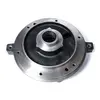Mobile:+86-311-808-126-83
Email:info@ydcastings.com
Gate Valve Casting Techniques and Their Applications in Various Industries
Understanding Gate Valve Casting An Essential Component in Fluid Control Technologies
The gate valve is a critical component in various industrial applications, primarily used to control the flow of liquids and gases. This type of valve operates by lifting a rectangular or circular gate out of the path of the fluid, providing minimal resistance to flow and making it an ideal choice for applications demanding a straight-line flow. However, the effective performance of gate valves heavily relies on the quality of its casting. In this article, we will explore the significance of gate valve casting, the common materials used, and the processes involved in manufacturing these vital elements.
The Importance of Casting in Gate Valves
Casting is a manufacturing process that involves pouring molten metal into a mold to create a desired shape. The casting process for gate valves is crucial as it determines not only the structural integrity of the valve but also its ability to withstand high pressures and temperatures. A well-cast gate valve can ensure reliable operation, minimal leakage, and extended service life, thus significantly reducing maintenance costs and downtime in industrial operations.
The casting process allows for intricate designs and shapes that can incorporate various features necessary for optimizing valve function. Additionally, it allows manufacturers to produce a high volume of uniform products, which is critical in industrial settings where consistency and reliability are paramount.
Common Materials Used in Gate Valve Casting
The choice of material for casting gate valves is vital to ensure durability and performance. Common materials include
1. Cast Iron This is a traditional choice for manufacturing gate valves. Cast iron is known for its excellent casting characteristics and good wear resistance. It is typically used in waterworks applications and food processing.
2. Ductile Iron Similar to cast iron but with increased tensile strength and ductility, ductile iron can withstand higher pressures and temperatures. It is often used in severe services, such as oil and gas applications.
3. Stainless Steel Valves made from stainless steel offer superior corrosion resistance and can handle higher pressures and temperatures. They are ideal for applications in chemical processing, pharmaceuticals, and food and beverage industries.
gate valve casting

5. Alloys Specialty alloys may also be employed to enhance performance characteristics, especially in extreme environments where standard materials may fail.
The Casting Process
The manufacturing of gate valves typically involves several key steps
1. Design and Mold Creation Engineers design the valve and create molds that reflect the desired dimensions and characteristics of the end product. Patterns are often made from the chosen material, ensuring precise replication in the casting process.
2. Melting and Pouring Selected metals are melted in a furnace to reach the desired temperature and then poured into the molds. This step requires meticulous attention to ensure that the metal flows evenly and fills all sections of the mold without forming air pockets or imperfections.
3. Cooling and Removal After pouring, the alloy cools and solidifies in the mold. Once cool, the cast is removed and undergoes inspection for defects.
4. Machining and Finishing The cast gate valves may need further machining to achieve the precise dimensions and surface finishes required. This step enhances sealing surfaces and improves overall functionality.
5. Testing Finally, each valve undergoes rigorous testing to ensure it meets the required operational standards, including pressure testing and visual inspections for any defects.
Conclusion
Gate valve casting is a sophisticated process that plays a fundamental role in the manufacturing of these essential components. The materials and methods used directly impact the performance and longevity of the valves, which are pivotal in maintaining seamless operations across various industries. As technologies advance, improvements in casting techniques, material science, and design innovations will continue to enhance the effectiveness and reliability of gate valves, ensuring their critical role in fluid control systems remains strong. Understanding the nuances of gate valve casting is essential for anyone involved in the design, manufacturing, or maintenance of fluid handling systems.
-
Impeller Technology That Powers Precision in Pump SystemsNewsMay.22,2025
-
Valve Durability Begins with Quality Cast Iron ComponentsNewsMay.22,2025
-
Performance Cooling with Advanced Automobile Water Pump SolutionsNewsMay.22,2025
-
How Motor Housing and Oil Pans Shape Engine PerformanceNewsMay.22,2025
-
How Metal Castings Drive Modern Manufacturing EfficiencyNewsMay.22,2025
-
Exploring the Engineering Behind Valve Body CastingsNewsMay.22,2025











